Elections 101: Slate Mailers v. Direct Mail Postcards


Now that election season is upon us again, the sheer number of campaign marketing tools available to candidates can be pretty overwhelming. From television ads to radio blurbs, parade appearances to campaign rallies, and direct mail postcards to slate mailers, the options can start to seem endless. So how do you choose?
Simple - the same way you want the voters to make their choice. You evaluate the options and compare their cost and efficacy. Look at the cost of each choice, evaluating the tangible effects (financial) and the intangible effects (does it damage your brand or reputation in any way, does it conflict with your principles or platform, does it create any unnecessary risk, etc.). Then, do your research on how effective each option is so that you can land on the one that gives you the biggest bang for your buck.
Fortunately, USPS - Deliver the Win commissioned the study, "The Direct Mail Effect with Voters" on political advertising in the state of Virginia following the 2017 and 2021 elections. They found that receiving direct mail about the election was ranked as the most credible form of political advertising by voters, at 68% of respondents (compared to TV ads at 59%, in home visits at 49%, and digital ads at 26%). The 2021 study also found that 75% of voters read direct mail pieces upon receipt, and 63% were prompted by direct mail to discuss the race with family and friends. 59% of respondents also indicated that direct mail motivated them to go online in order to fact check the candidates and their positions.
As a well-informed voter, this information should encourage you to consider choosing to utilize direct mail to promote your campaign. When it comes to political direct mail, there are two main contenders: slate mailers and direct mail postcards. Which one is right for you?
Because many may not be as familiar with the ins and outs of slate mailers, we'll delve into those first. Consider this our version of a voter guide comparing and contrasting two unconventional candidates: slate mailers and direct mail postcards.
Slate Mailer Basics
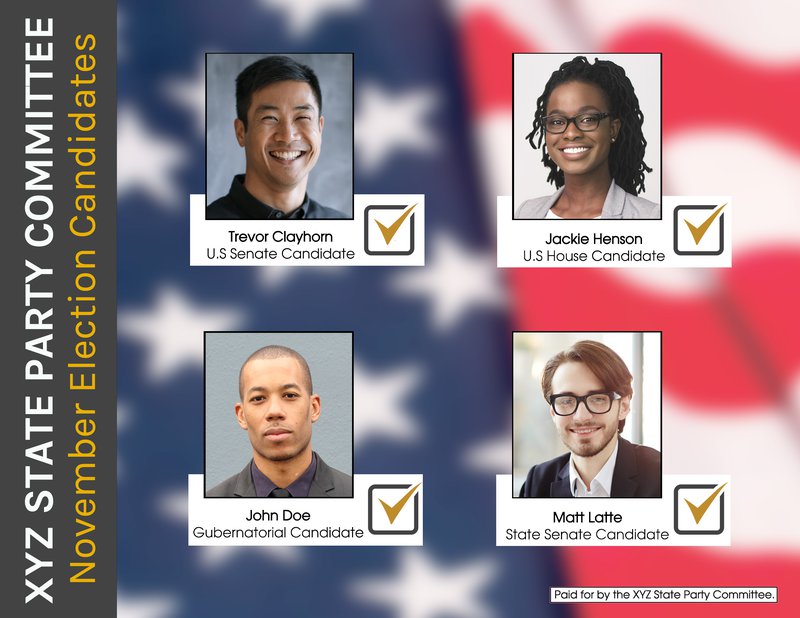
Slate Mailer Example via the Federal Election Commission
What IS a Slate Mailer?
According to the California Fair Political Practices Commission, A slate mailer is a mass mailing (more than 200 substantially similar pieces of mail sent in a calendar month) that supports or opposes a total of four or more candidates or ballot measures.
Slate mailers are produced by political groups with a specific agenda and are not always sent out by a legitimate political party. Ballotpedia puts it this way: "A slate mailer is a publication created by a campaign or for-profit consulting service that is mailed to voters and that contains lists of candidates or ballot measures, along with recommendations and endorsements."
The purpose of a slate mailer is to persuade recipients to get out and vote for the full "slate" of candidates or ballot measures listed on the mailing, and the mailer itself is designed in such a way that the recipient would believe that all those on the slate are in agreement on one or more issues that matter to the voter.
Candidates and ballot measure proponents can pay a set fee to be included in a specified number of mailers, but the mailer can also include other candidates and issues that have not paid to appear. The groups that put out slate mailers are called slate mailer organizations.
Slate Mailer Organizations
Ultimately, a slate mailer organization is any company that receives money in order to put out one or more slate mailers in an attempt to influence the outcome of an election. However, it is important to know a bit more than that. Here's what the good people of the California Fair Political Practices Commission have to say about it:
- A slate mailer organization is any person who directly or indirectly:
- Is involved in the production of one or more slate mailers and
- exercises control over the selection of candidates and measures to be supported or opposed in the slate mailers; and
- Receives or is promised payments totaling $500 or more in a calendar year for the production of one or more slate mailers.
- A slate mailer organization does not include:
- An officeholder, candidate, or their controlled committee;
- An official committee of a political party;
- A legislative caucus committee; or
- A committee primarily formed to support or oppose an officeholder, candidate, or ballot measure.
Clear as mud? The TL;DR is that slate mailer organizations solicit candidates and ballot measure proponents in hopes of including them on the slate mailer postcard they send out. Sending these mailers is the sole purpose of the slate mailer organization's existence.
Slate Mailer Requirements/Restrictions
As you can imagine, the world of slate mailers was the wild wild west for some time (and still is, depending on your location). However, there are a few states (most notably, California) that have stepped up to the plate with a few requirements. They include:

Slate mailers must include the Notice to Voters shown above. It must be of a specific format and size and in a predetermined location. It must be in English AND in the primary language of the mailer, if other than English. In addition, they must also feature the address of the slate mailer organization in a specific format, location, and size. As laid out in the Notice to Voters, an asterisk of the same size and type (not to exceed 10pt) must appear next to the name of every candidate or issue that has paid more than $100 to be included in the mailer.
Note: An asterisk should NOT be placed next to the name of any candidate or committee who has not paid to be included in the mailer, regardless of whether the candidate or committee approved the inclusion.
If a candidate listed in the mailer is of a different political party than the overall slate represents, the name of the candidate s party must appear directly below the candidate s name in 9pt type. Additional requirements exist for the use of governmental and nongovernmental logos and words that may appear to represent public safety officials or other organizations.
Slate mailer organizations must also file periodic statements disclosing: all payments received in connection with producing slate mailers; all payments made in connection with producing slate mailers; and the identity of each candidate or measure supported or opposed by each slate mailer.
Check out these resources from the California Fair Political Practices Commission for more details: What Is a Slate Mailer Organization and Slate Mailer Disclaimer Requirements.
The Upside of Slate Mailers...
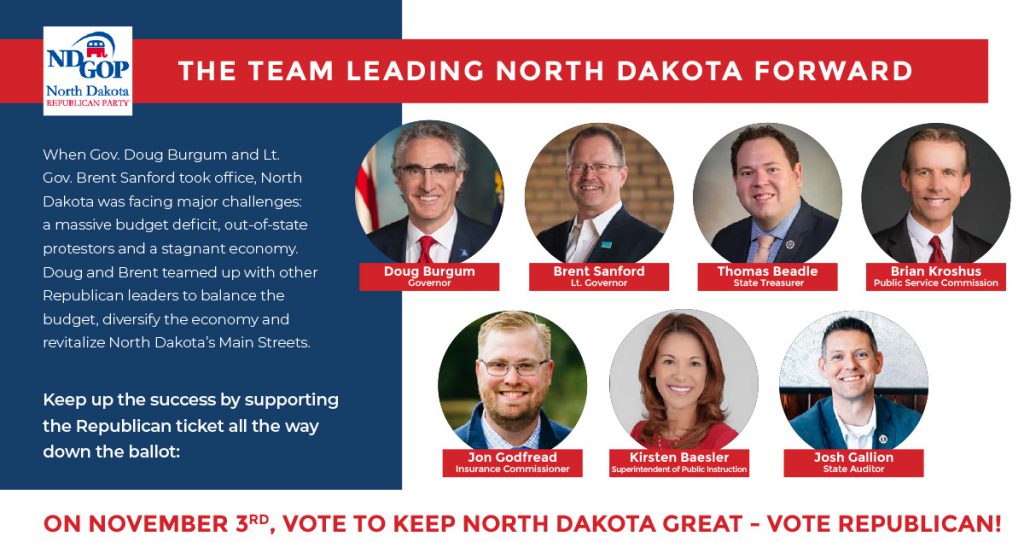
Slate Mailer Image via ND GOP
(This slate mailer was created by a political party and not a slate mailer organization.)
There are definitely some significant benefits to paying for space on a slate mailer. First, you can potentially gain greater visibility than you may otherwise have attempted to, simply by being featured alongside other bigger names. You may also find that your name makes it in front of voters who are already likely to share your ideals.
In addition, since you re only paying a set fee, you don t have to bear the entire cost of a mass mailing. The slate mailer organization also handles the whole design and mailing process for you, so you can be relatively hands-off. These are all attractive incentives for any candidate looking to make a name for themselves.
...And the Downsides.
While the upsides to working with a slate mailer organization seem pretty irresistible, there are some pretty heavy downsides to consider - both for you, the candidate, and for you, the voter.
...for the Candidate
Since you are only paying for space, you will not have any control over who the other candidates and issues featured on the mailer will be. You also cannot control who else can contribute to the mailing, and you will have zero brand control. You may find yourself on the same mailer as someone who supports an issue you have staunchly opposed for your entire career, simply because they paid to be there. Or, one of the other candidates listed on the slate may have a very public fall from grace, and your perceived "support" of him or her could come back to haunt you.
This might not seem like such a big deal, but if your reputation matters to you at all, this lack of control can make you seriously vulnerable to a variety of potentially damaging negative associations. Pay to play political advertising is like playing with fire - just when you think you've got a handle on it, it can come at you from a different angle. After all, politics IS perception. Giving up your ability to control the narrative can be a serious risk.
After all, politics IS perception. Giving up your ability to control the narrative can be a serious risk.
...for the Voters
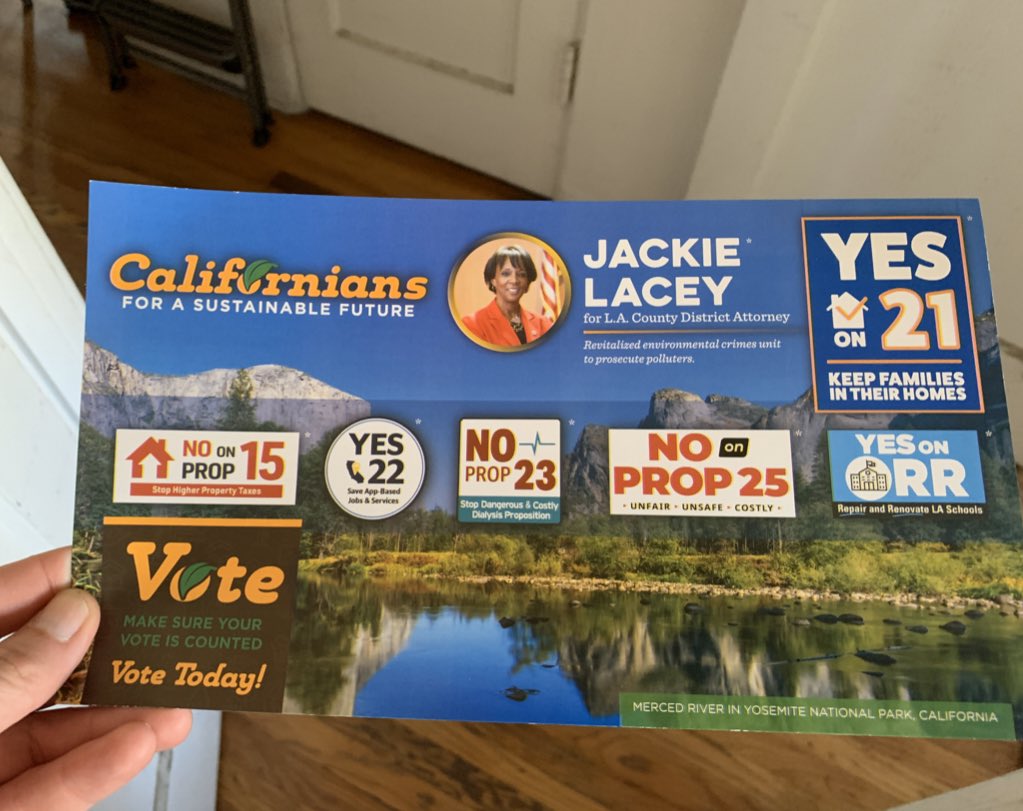
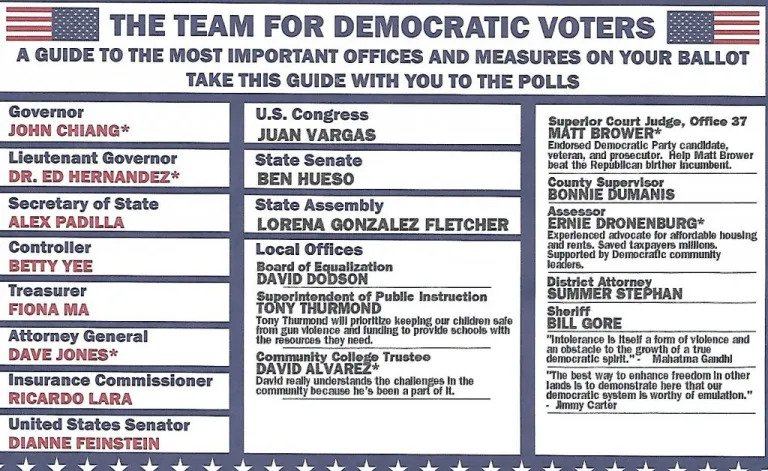
"Californians for a Sustainable Future" via L.A.TACO | "The Team for Democratic Voters" via San Diego Free Press (the last 4 names are Republicans)
The aim of a slate mailer is to persuade you to vote a certain way so that the results of the election are impacted and the slate mailer organization s profits go up. Because the slate mailer organization is not unbiased, an alert and engaged John or Jane Q. Public has to do a lot of work in order to determine whether what he or she is reading is true. For those voters who are easily misled, an unscrupulous slate mailer organization can do a lot of damage.
Unfortunately, there are numerous examples of slate mailers that have been sent out to unsuspecting voters claiming to represent groups with catchy names, like California Public Safety Voter Guide, Woman s Voice, and the National Tax Limitation Committee. In reality, all 3 of those mailers are published by the same slate mailer organization, Landslide Communications, in Irvine, California.
Why does that matter, you ask? When a voter sees the name of an organization that sounds official and seems to line up with their own values and political ideals, they may feel compelled to believe that this organization of kindred spirits have actually vetted and thoughtfully endorsed these candidates in issues. However, these organizations don t actually exist beyond the pages of a slate mailer. They re simply useful tools to garner the attention and votes of the none-the-wiser general public.

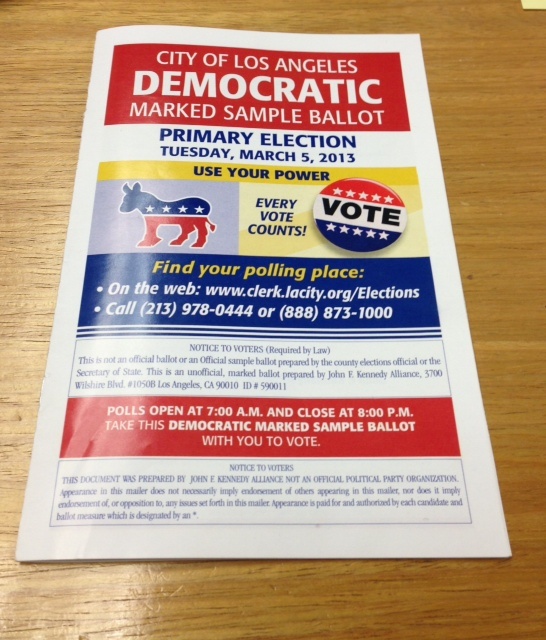
Misleading Slate Mailer Examples via KNOCK.LA and KPCC
Progressive Voter Guide from "Feel the Bern" | Democratic Marked Sample Ballot from "The John F. Kennedy Alliance" (not affiliated with the Democratic Party in any way)
Some slate mailer organizations also give their mailers intentionally misleading titles, such as Democratic Sample Ballot to give the appearance of being an official publication of a real political party. This can lead to trusting voters inadvertently casting their ballot for candidates and causes they otherwise would not have. There s nothing wrong with a political party sending out a slate mailer of their candidates in order to encourage party supporters and others to vote for them, and those do not fall under the same restrictions as a slate mailer put out by a for-profit organization. However, that does mean that voters have to put in a lot of extra work to sift through the mail they receive.
Political Direct Mail Postcards


Political Postcard Designs via MyCreativeShop
The Basics
Political direct mail postcards are sent out to prospective voters by campaigns and committees in order to persuade the reader to vote for them or to vote a certain way on their ballot measure. Just like a slate mailer, these postcards are colorful and vibrant, attracting the eye. Unlike a slate mailer, though, these postcards are put out in support of a single candidate (or ticket) or issue, and are sent by an organized campaign, committee, or party (not a slate mailer organization) that is not a for-profit company unaffiliated with any one candidate or ballot measure.
Political Direct Mail Postcard Campaigns
To create a political direct mail postcard for your campaign, you can always ask your campaign manager who moonlights as a graphic designer to give you a hand. If you don't have one in your arsenal, we recommend customizing an existing political postcard template and launching your direct mail campaign from there.
MyCreativeShop s all-in-one direct mail service offers a variety of customizable political postcard templates for you to choose from. Our templates already include the necessary layout requirements to be sent as USPS Direct Mail, so you don t have to worry about those details.
All-in-one means that we handle everything, from printing to mailing, without you having to ever go to the post office. You ll simply choose the template that works for you and make your customizations. After you ve verified your final design, you can upload your mailing list, choose your recipients by ZIP code and postal route, or use our best-in-class list builder tool to send your postcards to people who fit the demographics of your target audience. Finally, you ll choose your mailing dates and it s off to the races!
*********************************************************************************
The Verdict
Slate mailers can provide big bang for your buck and gain you a lot of exposure. At the same time, what you save in cost, you give up in control. Because direct mail is such an effective political marketing tool, political direct mail postcards created by and for your campaign and sent out using an all-in-one direct mail service are an affordable and effective option to help you get out the vote!